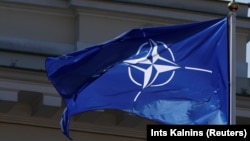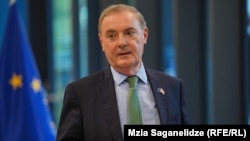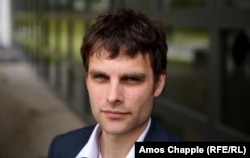
Welcome to Wider Europe, RFE/RL's newsletter focusing on the key issues concerning the European Union, NATO, and other institutions and their relationships with the Western Balkans and Europe's Eastern neighborhoods. To subscribe, click here.
I'm RFE/RL Europe Editor Rikard Jozwiak, and this week I'm drilling down on four things to watch for at the NATO summit in Vilnius on July 11-12: what Ukraine can expect; Sweden’s membership prospects; the alliance’s defense plans; and the bloc’s relationship with other partners.
Brief #1: What Will Ukraine Get?
What You Need To Know: For Ukraine, this summit is about avoiding another “Bucharest” or “Budapest.” “Bucharest” refers to the 2008 NATO summit in the Romanian capital at which the military alliance famously stated that Ukraine (and Georgia) would become members but avoided any specific timetable or pathway.
Everyone is acutely aware that the NATO summit declaration in Vilnius won’t invite Kyiv to become a member then and there.
No one around the table has any appetite for giving a country in the middle of a war Article 5 guarantees (making an attack on any NATO member an attack on all). Instead, they will try to find a way to promise Ukraine membership once things look better.
That’s where “Budapest” comes into play.
It’s a reference to a trio of 1994 memorandums in which Russia, the United Kingdom, and the United States gave security assurances to Ukraine (and Belarus and Kazakhstan) in exchange for Kyiv giving up its Soviet-era nuclear weapons.
While Ukraine awaits possible NATO membership, it wants “guarantees” or “assurances” that the West will continue to support it militarily. Quite how this might be spelled out will remain one of the summit’s head-scratchers.
Drilling Down
- Most NATO officials I’ve spoken to quietly concede that there is really just one ironclad security guarantee: NATO membership. That’s something that Finland and Sweden realized (more on that in a moment) when applying to join so quickly after the invasion. All other measures, such as security assurances, can essentially only be offered on a bilateral basis by alliance members.
- It could be that a group of nations in the run-up to the summit or in Vilnius will pledge to support Ukraine militarily for “as long at it takes” by providing more weapons, ammunition, or even training for Ukrainian troops. Don’t rule out the possibility of a separate Group of Seven statement to that effect either, especially as all members of that group will be in Vilnius. (Japanese Prime Minister Fumio Kishida will also attend.)
- What NATO will offer as an organization is a pot of 500 million euros ($538 million) a year for the foreseeable future to assist Ukraine on various military expenditures. This sum could potentially grow in the future, too.
- Otherwise, the biggest issue lies in semantics: How can a declaration be written so as to avoid another “Bucharest” and not disappoint Ukraine but at the same time reassure cautious countries like the United States and Germany? They are wary of any membership commitment in wartime against a nuclear-armed Russia, as evidenced by U.S. President Joe Biden’s warning that there’s not “unanimity” on Ukrainian membership “at this moment, in the middle of a war.”
- One way might be to state that Kyiv will join once “conditions” or “consequences” allow, and perhaps even to describe them explicitly. It could be that some sort of pathway will also be spelled out -- for example that NATO allies will issue an assessment or return to the question at the next summit, in Washington, D.C., next summer.
- Ukraine is also fighting to avoid a requirement for a Membership Action Plan (MAP) before it can join. A MAP is a sort of NATO membership “antechamber” in which the aspirant gets a tailor-made national program to prepare for future membership, and it could cover not only defense aspects but also political, security, and legal issues that the alliance thinks need to be addressed. Many of the current Central and Eastern European NATO members needed a MAP before joining. But there are indications from officials that Kyiv won’t need one -- just as Finland and Sweden weren’t required to have one before starting the membership process.
- In the end, the biggest question is whether Ukrainians will be satisfied with the outcome of the summit. While it is very much expected that Ukrainian President Volodymyr Zelenskiy will show up, there have been persistent rumors that he is toying with the idea of not coming if he feels the summit isn’t ambitious enough. Still, most expect him to be there and to co-chair the inaugural NATO-Ukraine Council -- an updated political relationship in which Kyiv will be sitting at the table as a sort of coequal, with the right to call meetings with the military alliance whenever it sees fit.
Brief #2: Sweden's NATO Accession?
What You Need To Know: This is an issue that not many NATO officials expected would drag on for so long. Sweden applied to join alongside Finland in the spring of 2022 as a direct consequence of Russia’s full-scale invasion of Ukraine, and many diplomats expected the process to be wrapped up by autumn.
But Ankara had other plans.
Before green-lighting membership, Turkey demanded that the Nordic pair, or more specifically Sweden, lift an arms embargo against Turkey, update its counterterror legislation, and extradite individuals whom Turkey has deemed to have been engaged in terrorist activities.
While Turkey agreed that both Sweden and Finland would join at the NATO summit in Madrid last year, Ankara withheld ratification of the Accession Protocols until progress was made.
Issues with Sweden, notably demonstrations in Stockholm that included the burning of a Koran, particularly strained Ankara-Stockholm relations before Finland decoupled and joined NATO alone in early April.
Drilling Down
- There are essentially two ways this can go: There could be a repeat of the Madrid summit in which Turkish President Recep Tayyip Erdogan meets with Swedish Prime Minister Ulf Kristersson in Vilnius a day before the start of the summit to seek an agreement, paving the way for ratification in the Turkish parliament in July or the autumn; or the pair could end up holding “constructive talks” in the Lithuanian capital that conclude with more work still to be done at various diplomatic levels.
- NATO Secretary-General Jens Stoltenberg met with the foreign ministers and intelligence and security chiefs of Finland, Sweden, and Turkey on July 6 to try to iron out lingering details ahead of Vilnius. He described the meeting afterward as “productive” and suggested it is “possible to have a positive decision” the week of the summit.
- NATO officials I’ve spoken to on condition of anonymity believe Erdogan still would like to be viewed as a key statesman and agree on something once full media attention is directed at the summit. They note that expectations were low approaching the Madrid summit as well, but say face-to-face talks at the highest level then paved the way for an agreement.
- They do, however, note that there might be another meeting needed as well: between Erdogan and Biden, at which the latter could promise American deliveries of F-16 fighter jets to Ankara -- a move that many believe could be deal clincher.
- But more Koran burnings in Sweden, for instance, could still prove to be a potential spoiler. Turkey and much of the Muslim world reacted with fury when permission was granted for someone to burn the Muslim holy book outside a Stockholm mosque on June 28 in a protest to coincide with Eid al-Adha, one of the Islamic calendar’s holiest events.
- The protest was permitted by a Swedish court after similar requests had been turned down, with authorities citing national security risks. At least three permits for the burning of religious books have been lodged in recent days, and the Swedish authorities now face a real headache. Diplomats I’ve spoken to say that Swedish officials will tell their Turkish counterparts that the latest Koran burner at least was charged with agitation against an ethnic or national group, and that they plan similar charges if any similar incidents happen.
- If there is a deal in Vilnius, it is widely thought that the Turkish parliament could still approve the ratification instrument before it goes into recess by October. Hungary has not ratified Sweden’s accession protocol, either -- mainly in solidarity with Ankara. While there are indications that Hungarian lawmakers postponed the vote to their autumn session, Budapest has repeatedly noted that it won’t be the last country to ratify; so don’t quite rule out Sweden becoming NATO member number 32 already this month.
Brief #3: Sorting Out NATO's Core Tasks
What You Need To Know: Perhaps the single most important decision that will presumably be taken at the NATO summit is the unanimous approval of the military alliance’s first comprehensive defense plans since the end of the Cold War.
These represent NATO’s bread and butter: How to defend every inch of the 31 member states’ territories. Four thousand pages of classified plans should be green-lighted, covering three major regions: the North, meaning the Atlantic and the Arctic regions; the central region that essentially covers Europe from the Baltics to the Alps; and a southern region extending south from the Alps to the Mediterranean and including NATO states around the Black Sea. Of course, there are also subsections focusing on, for example, cybersecurity.
If all goes well and the plans are approved at the summit, even more detailed planning will follow that informs battalions as to exactly what patch of territory or sea they should defend in case of attack.
Drilling Down
- These plans were essentially supposed to be agreed ahead of the summit, but there have been some obstacles -- mostly involving Turkey. Ankara has, for example, insisted on calling the Bosphorus “the Turkish strait” in the plans and also wanted to put more emphasis on fighting terrorism rather than simply focusing on the threat posed by Russia.
- But the big issue remains how to go from plans to reality, and that ultimately means: Is there enough military gear, soldiers, and money to achieve all of that? Now, NATO is good at making commitments. In Madrid last year, the allies agreed that they would have 100,000 troops ready to deploy within 10 days and 300,000 inside of a month. But they still haven’t reached that lofty target.
- It has fared even worse when it comes to defense spending. At the NATO summit in Wales back in 2014, a pledge was made that every ally would spend 2 percent of gross domestic product on defense by 2024 -- a figure all NATO members managed to reach during the Cold War. One year before that pledge should have been fulfilled, the alliance as a whole isn’t even close to achieving it.
- Only seven countries -- Estonia, Greece, Latvia, Lithuania, Poland, the United Kingdom, and the United States -- reached the 2 percent threshold in 2022. In 2023, newest NATO member Finland will join the club, as will Hungary, Romania, and Slovakia. Germany should get there next year and France in 2025. But several NATO officials point out that quite a few countries might reach the 2 percent target, only to drop under it again shortly thereafter.
- Thus, the new pledge in Vilnius. The 2 percent target should be “the floor” rather than the “ceiling.” That’s no problem for countries like Estonia, Poland, and the United States, which all spend 3 percent or more. But for others, it might be just another empty promise.
- Another issue is that NATO will once again need to return to basics. After 20 years of largely guerrilla fighting in Afghanistan, there is a perceived need for investment in jets, tanks, and artillery -- and this was an acute need even before many NATO allies started sending such military hardware to Ukraine.
- There is also the production of artillery. Even though European countries are slowly scaling up, largely to provide Kyiv with more rounds, Russia is still firing Europe’s monthly artillery production rate (currently estimated at 20,000-25,000 shells per month) in a single day in Ukraine.
Brief #4: All Of NATO's Other Friends
What You Need To Know: All the spotlight at the summit will doubtless be on Ukraine, but there are other non-NATO countries present in Vilnius, too.
On the first day, July 11, there is an informal North Atlantic Council (NAC) meeting together with “Partners at risk” -- in this case, Bosnia-Herzegovina, Georgia, and Moldova -- all of which will be represented by their respective foreign ministers.
On the second and final day, July 12, there will be a NAC meeting with the leaders of the four “Indo-Pacific Partners” -- Australia, Japan, New Zealand, and South Korea -- repeating a format first used in Madrid in 2022.
The Indo-Pacific meeting very much reflects the growing worry within the alliance about China; but there are divisions inside the club as to whether NATO is the appropriate forum when it comes to addressing issues pertaining to Beijing.
Drilling Down
- One clear result of this internal tension is that NATO still hasn’t reached consensus on opening a NATO office in Tokyo, with France no big fan of the idea. At the summit, however, NATO will draw up new cooperation programs with the Indo-Pacific quartet that cover areas like maritime, cyber, and new tech.
- Combining Bosnia-Herzegovina, Georgia, and Moldova into one session is rather odd. The first two are NATO aspirants that, like Ukraine, have offers of future membership but no concrete timetables. Moldova, on the other hand, is constitutionally neutral and its population is deeply divided on potential membership.
- For Georgia, it’s also a bit of downgrade. Tbilisi has until recently gone “hand-in-hand” with Ukraine when it comes to NATO membership; not so anymore. NATO officials I’ve spoken to say this “decoupling” simply reflects a reality that the Ukrainian leadership is currently pushing harder for NATO membership.
- Speeches like the one made by the Georgian Prime Minister Irakli Gharibashvili at the Globsec summit in Bratislava, in which he blamed the war in Ukraine on NATO enlargement, certainly haven’t helped. But what I hear from the NATO corridors in Brussels is that Tbilisi needs to do more to fix Georgia-Ukraine relations and show greater political support for Kyiv. The hope is still that Ukraine can offer a precedent for Georgia going forward on its NATO path.
- At the summit, the allies will continue to pledge money to boost Georgia’s defense capabilities, notably in the area known as CBRN (chemical, biological, radiological, and nuclear defense) and to refurbish a number of training facilities in the Caucasus country.
- For Bosnia-Herzegovina, the expectation is of an agreement on a 30 million-euro support package, financing 12 projects in fields such as cybersecurity, air medical evacuation, and boosting its military police.
- With Moldova, NATO has devised a so-called “enhanced defense-capacity-building package” focused on fighting disinformation, responding to cyberthreats, and modernizing the country’s defense institutions.
- Interestingly, in light of the recent unrest in northern Kosovo in which NATO KFOR troops were attacked, that country is not formally on the agenda. KFOR’s presence has now been boosted by 500 soldiers, bringing the total number of peacekeepers to 4,300; but no discussions are expected on that issue at the summit unless one of the leaders explicitly brings it up.
That's all for this week. Feel free to reach out to me on any of these issues on Twitter @RikardJozwiak, or on e-mail at jozwiakr@rferl.org.
Until next time,
Richard Jozwiak
If you enjoyed this briefing and don't want to miss the next edition, subscribe here.




